Sphinginae subfamily
Sphingini tribe:
 |
Pink-spotted hawkmoth -- (Agrius cingulata) WO
unlikely stray
This moth is a very strong flier, but would only make its way to
Oswego as a rare stray. There are not too many records from New York state.
|
 |
Ceratomia amyntor
WO,
the Elm Sphinx or Four-horned SphinxThe upperside of the forewing is brown with dark brown and white
markings including a white costal area near the wing base, dark
streaks along the veins, and a white spot in the cell.
Larvae feed on Elm (Ulmus), birch (Betula), basswood (Tilia), and
cherry (Prunus).
|
 |
The upperside of the forewing is pale brownish gray with wavy black
and white lines and a black-outlined white cell spot.
It is named for the wavy lines on the forewings. |
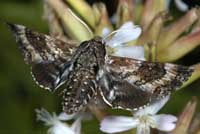 |
This moth is not recorded in Onondaga, but has been taken in more
northerly locations in Michigan, New Hampshire and Vermont, so it should be present.
|
 |
The upperside of the forewing is gray with heavy black bands.
The upperside of the hindwing is brownish gray with no markings.
If you have pines, you
probably have this species. It also flies on P.E.I.
|
 |
Lintneria eremitus WO, the
Hermit Sphinx.
The upperside of the forewing is gray-brown with wavy lines,
black dashes, and one or two small white spots near the center of
the costa. The upperside of the hindwing is black with two white
bands and a triangular black patch at the base. Note the golden hair
on the thorax.
|
 |
This large bodied moth flies in tobacco fields and vegetable gardens
(potatoes, tomatoes) and wherever host plants are found.
|
 |
Sphinx chersis USGS, the Northern Ash Sphinx or Great Ash Sphinx
The upperside of the forewing is soft dark gray to blue-gray
with a series of black dashes, one of which reaches the wing tip.
|
 |
Forewings, long and slender, are held close to the body when
the moth is at rest. The top third of the forewing in the basal and median
areas is grey while most of the rest of the forewing
is dark brown.
|
 |
Colouration and markings are highly variable from one specimen to another.
The fringes on forewing are mostly black with some white; those on
the hindwing are mostly white with a few black patches.
|
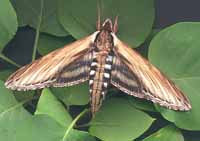 |
The lower forewings are predominantly brownish-yellow with a
fairly wide dark bar along the inner margin. At rest the wings
hug the body, giving the moth a long slender look.
|
 |
Sphinx luscitiosa
WO,
the Canadian Sphinx or Clemen's Sphinx
The upperside of the forewing is yellowish gray in males and pale gray with a faint yellow tint in females. In both sexes, the dark border on the outer margin
widens as it approaches the inner margin.
|
 |
If you have blueberries in the woods, then you probably have the
Poecila Sphinx.
They are pretty common here on Prince Edward Island, and
I suspect
would be present around blueberry fields in Onondaga. |
Smerinthini Tribe:
 |
The adults are also highly variable; sometimes wings of an individual
may be all one color or may have several colors, ranging from pale to
dark brown, and may have a white or pink tinge.
See the file for the female; she is different.
|
 |
Pachysphinx modesta
WO,
the Modest Sphinx or Poplar Sphinx,
Hindwings aremostly deep maroon with some dark blue-black scaling.
They are a heavy bodied species.
|
 |
The outer margin of the forewing is quite wavy. There is a dark cell
spot and a dark oblique line mid wing from the costa almost to the
inner margin. Basic ground colour is pinkish brown. Flight would
be June-July. |
 |
This species ranges across North America.
The hindwings have a small blue eyespot ringed with black on a yellow
background.
|
 |
Smerinthus cerisyi
WO, the Cerisyi's
Sphinx or One-eyed Sphinx, Larvae feed on poplars and willows.
Flight would be from late May-July as a single brood.
|
 |
Smerinthus jamaicensis closely resembles Smerinthus cerisyi,
but jamaicensis is much smaller with larger blue patches on more
vibrant and deeper purple in the lower wings.
|
Macroglossinae subfamily
Dilophonotini tribe:
 |
Hemaris thysbe
WO, the Hummingbird Clearwing
This interesting day flier is now reported in
Oswego, and is widely
reported to the north, east and south.
They are widely distributed in the east from P.E.I. to Florida.
|
 |
Hemaris diffinis
WO, the Snowberry Clearwing or Bumblebee Moth
This moth is widely distributed and has been reported in Oneida and
in Vermont, New Hampshire and Maine.
|
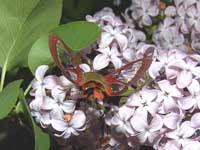 |
Hemaris gracilis
WO, The Slender Clearwing or Graceful
Clearwing
This day flier is not commonly reported, but it might be present in
Onondaga County.
|
Philampelini tribe:
 |
Adults nectar from flowers of Japanese honeysuckle
(Lonicera japonica), petunia (Petunia hybrida), mock orange
(Philadelphus coronarius), and phlox (Phlox).
Note the differences between this moth and the Pandorus Sphinx.
questionable, northern range limit
|
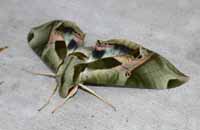 |
If you have Grape or Virginia Creeper nearby, then you probably have
this species. I often get asked to identify larvae from areas where
they have not previously been reported.
|
Macroglossini tribe:
 |
This day flier is widely distributed. If you have Virginia Creeper, you
probably have the Nessus Sphinx, and it is now reported from
Oswego.
Two bright, distinct, narrow yellow
bands are often visible on the abdomen.
|
 |
The lower wings of this hawkmoth are a solid brownish-orange,
matching the body colour.
You will often see this species listed as Darapsa pholus,
especially in older literature.
|
 |
Darapsa myron
WO, the Virginia Creeper Sphinx or the Grapevine Sphinx
The forewing upperside is dark brown to pale yellowish gray, with an
olive green tint.
On the costal margin there is a dark rectangular patch, although this
may be reduced or absent. The upperside of the hindwing is
pale orange.
|
 |
If you have hydrangea growing near a stream, then you may have the
Hydrangea Sphinx.
It has not been widely reported north of Oswego,
however, and probably is uncommon.
|
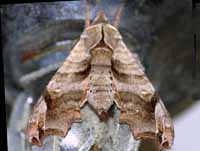 |
The moth's outer margin of the forewing is deeply scalloped.
The upperside is light brown with dark brown markings.
There is a small black and white spot near the tip.
The upperside of the hindwing is orange-brown with a dark brown
outer margin and median line.
|
Deidamia inscriptum, Clay, April 16-17, courtesy of Randy Lyttle.
 |
Hyles gallii WO, the Bedstraw Hawk Moth
or Gallium Sphinx
The thick, cream-coloured, slightly irregular, diagonal line on the
forewing as well as the absence
of much thinner "white lines/streaks" distinguish this species from
Hyles lineata.
|
 |
Hyles lineata
WO, the White-lined Sphinx
Adults usually fly at dusk, during the night, and at dawn, but they
also fly during the day over a wide variety of open habitats
including deserts, suburbs, and gardens.
|
 |
Proserpinus flavofasciata
WO, the Yellow-banded Day Sphinx:
Fw upperside is medium to dark brown with a faint to distinct white median band.
Hw upperside is dark brown with a wide orange median band which may not reach the inner margin. The moth mimics a bumblebee.
Questionable, generally more northerly.
|
 |
This moth is very much under reported across the United States. It
is a rapid day flier so is probably not in too many collections.
Grape is a popular larval host.
|
|
|
